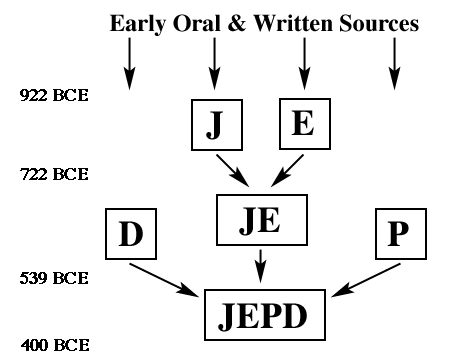5 Sources for the Torah

If a person can only talk from their own perspective about the Bible as a historically accurate document, and are concerned that saying that various pieces of information in the Bible aren’t true because that would somehow invalidate the Bible as unreliable for our faith, then they are missing the point of what the editors and writers of the various parts of the Bible were doing in the first place.
People who equate truth with historical fact will certainly end up viewing the Bible dismissively, as a naïve and unsophisticated web of lies, since it is replete with elements that cannot be literally true. But to view it this way is to make a genre mistake. Shakespeare’s Hamlet, while set in Denmark, an actual place, is not historical fact. But that doesn’t make it a naïve and unsophisticated web of lies, because one accepts when reading or watching Hamlet that it is not a work of historiography, a work of writing about history. It is a work of literature. And in deference to that genre and its conventions, one can know and accept that the truths conveyed are not of historical fact, but are social, political, ethical, existential truths.
The Bible deserves at least the same courteous attention to its genres as Hamlet! The Bible doesn’t pretend to be, and shouldn’t be read as, what we would call “objective history” — in other words a bare narration of events. Some events that are mentioned in the Biblical texts correlate to events known from sources outside the Bible. So for example, Pharaoh Shishak’s invasion of Palestine in 924 BCE is mentioned in the Biblical text and it’s mentioned in the Egyptian sources — so there is a nice correlation. The destruction of the northern kingdom of Israel in 722 BCE, the capture of Jerusalem in 597 BCE, the destruction of the temple in Jerusalem in 586 BCE — these are all recorded in the Biblical text and they are in Assyrian and Babylonian records as well. This same correlation goes as well with other events from the period of the Israeli monarchy. So as a result, because of these correlations, many scholars are willing to accept the general Biblical chronology of the period from the monarchy on: starting about 1000 BCE on, they accept that general chronology of Israeli kings and battles and other events recorded in the Bible.
For centuries, devout people of faith, both Jewish and Christian, have held firmly to the belief that Moses wrote the 5 books of the Torah. They are even called the book of Moses! But this is an authorship that, especially in the last 300+ years, has been under scholarly scrutiny. There are still people who will hold fast to this belief, as they seem to think that attributing these books to Moses is an extremely important claim in their faith. It seems strange, however, that even though it seems perfectly acceptable to have anonymous authors for many other books of the Bible, that somehow people cannot also have anonymous authors for these first 5 books of the Bible.
By the mid to late 1600s, both Jewish and Christian scholars were questioning the authorship attribution of the Torah to Moses, pointing to stylistic differences in the writing, phrases that made no sense when attributed to Moses (or someone else who would have lived at the time of Moses) and the reality that there would be no direct way for Moses to have had real knowledge of things that happened thousands of years before his lifetime. Even when people indicate that God must have dictated the materials, word for word, to Moses, there are just plain problems with consistency within the Torah narratives. And somehow attributing inconsistency to God doesn’t work very well for most people of faith.
There is in the Torah some real evidence of multiple authors. In Biblical scholarship, the documentary hypothesis proposes that the Torah was not literally revealed by God to Moses, but represents a composite account from several later documents and/or oral traditions. This approach to reading the Torah indicates that the different authors had very different styles of writing, uses of words, and historic context.
Four basic sources are identified in this scholarly theory, designated as “J” (Yahwist), “E” (Elohist), “P” (Priestly), and “D” (Deuteronomic), usually dated from as early as the ninth or tenth century BCE for J and E, through the fifth centuries BCE for D and P. This approach to the Torah, the documentary hypothesis, was expressed in the late nineteenth century through the work of Karl Heinrich Graf and Julius Wellhausen and is thus also referred to as the Graf-Wellhausen hypothesis.
Example: documentary hypothesis is also called “Source Criticism”
“Modern literary conventions forbid plagiarism, and require authors to identify and acknowledge any material they have borrowed from another writer. But in ancient times it was common to “write” a book by transcribing existing material, adapting and adding to it from other documents as required, and not indicating which parts were original and which borrowed. The Torah contains few books which are the work of a single author throughout; for the most part its books are composite, and in some cases the source materials are drawn from original documents that may be spread over several centuries. Source criticism seeks to separate out these originally independent documents, and to assign them to relative (and, if possible, absolute) dates.” . JOHN BARTON, “Source Criticism,” The Anchor Bible Dictionary
The documentary hypothesis proposes that the Pentateuch as it is now was created sometime around the fifth century BCE through a process of combining several earlier documents—each with its own viewpoint, style, and special concerns—into one. It identifies four main sources, each with those nicknames of J, E, P, and D, that are still used in Biblical study today.
The specific identity of each author remains unknown. It helps that textual elements (word uses, place names, human names, etc) identify each source with a specific background and with a specific period in Jewish history.
J (the Jahwist or Yahwist) uses YHWH as a name for God in the writing that the writer has done. This source’s internal indications (again, names, places, etc) indicate that the writer of this material probably lived in the southern Kingdom of Judah in the time of the divided Kingdom, and as writing around the ninth century BCE. The J source is responsible for most of the content found in Genesis.
E (the Elohist ) uses Elohim (“God”) for the divine name until early in the book of Exodus, where the name YHWH (I am who I am) is revealed to Moses. This source seems to have lived in the northern Kingdom of Israel during the divided Kingdom. E wrote the story in Genesis 22 (the sacrifice of Isaac) and other small parts of Genesis, and much of Exodus and Numbers. The difference in this voice from that of the Yahwist is clear in part because of the use of the name Elohim or El to refer to God. El is an old Canaanite deity, and there is some feeling that this name may come from the Canaanite pantheon.
J and E were joined together fairly early in the history of compiling the Torah materials, apparently after the fall of the Northern Kingdom in 722 BCE. It is sometimes a little difficult to separate the J from the E stories that have merged. This consolidation likely happened between the fall of northern Israel and the destruction of Jerusalem between 597-586 BCE.
D (the Deuteronomist) wrote almost all of Deuteronomy (and probably also Joshua, Judges, Samuel, and Kings). This source would have lived in the southern Kingdom of Judah because the northern kingdom had been overrun and conquered by the Assyrians. Scholars often associate Deuteronomy with the book found by King Josiah in 622 BCE (see 2 Kings 22), but they believe that the time frame of the actual writing of the D material was written as early as King Hezekiah’s reform (who reigned from 716 to 687 BCE).
P (the Priestly source) wrote Genesis chapter 1; the book of Leviticus; sections with genealogical information, information about the priesthood, and the materials concerning the rituals of worship. For a time frame for these writings, scholars view P as containing materials written prior to the Babylonian exile (before 586 BCE) during the exile, and shortly after the Exile ended, about 538 BCE. Therefore, this source would have lived in the southern Kingdom of Judah, in Babylon, and in Jerusalem after the Babylonian exile. It was a time when the religious leaders wanted to firm up the traditions, history, mythology and stories of the Hebrew people, so that these would not be lost to the people of Israel during that time in exile, away from their homeland.
“R” is one more voice that contributes to the whole, and this voice is called the Redactor. R is considered to have completed the work of compiling the Torah, adding transitional elements to weave the stories together as well as some adding explanatory comments. It is believed that this happened sometime after the Jewish exiles returned to Jerusalem from the Babylonian Exile in the late sixth and early fifth century B.C.E.
We can diagram the relationship of the four sources as follows.

Contemporary scholars disagree that this is the only way to approach the Torah writings, but the general idea that there are multiple voices who wrote down the material found in the five books of the Torah is one of general consensus today among most Biblical scholars.
Here are some differences between the four strands of tradition.
| J Jahwist |
E Elohist |
P Priestly |
D Deuteronomist |
|||
| emphasizes the importance of the southern Kingdom of Judah |
emphasizes the importance of the northern Kingdom of Israel |
emphasizes the importance of the southern Kingdom of Judah |
emphasizes the importance of the central shrine which is the Temple in the city of Jerusalem, located in what had been the northern Kingdom of Israel |
|||
| stresses the importance of leadership in determining the fate of the Jewish people | stresses the importance of prophets and prophetic statements | stresses the importance of proper worship and the following of rituals and religious laws | stresses the importance of fidelity to Jerusalem and to the central shrine in the Temple | |||
speeches about God give God human qualities |
refined speech about God | majestic speech about God | speech recalling God’s work | |||
God walks and talks with us |
God speaks in dreams | Worship driven approach to God | moralistic approach | |||
God is YHWH |
God is Elohim (till Ex 3) | God is Elohim (till Ex 3) | God is YHWH | |||
uses “Sinai” |
Sinai is “Horeb” | has genealogies and lists | has long sermons |

Documentary hypothesis. (2020, August 26). New World Encyclopedia, . Retrieved 17:30, January 21, 2022 from https://www.newworldencyclopedia.org/p/index.php?title=Documentary_hypothesis&oldid=1041412. License: Creative Commons BY-NC-SA
Christine Hayes, Introduction to the Old Testament (Yale University: Open Yale Courses), http://oyc.yale.edu (Accessed Jan 21, 2022). License: Creative Commons BY-NC-SA
British Library Sacred Texts: Judaism, Sept. 2019, https://www.bl.uk/sacred-texts/videos/judaism.
May, Herbert G., et al. The New Oxford Annotated Bible with the Apocrypha: Revised Standard Version, Containing the Second Edition of the New Testament and an Expanded Edition of the Apocrypha. Edited by Michael D Coogan, Oxford University Press, 2007.
Gabel, John B. The Bible as Literature: An Introduction. Oxford University Press, 2006.
